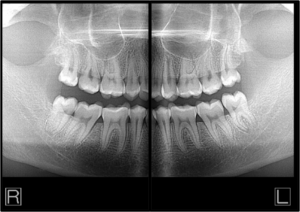Can Dental Radiographs Indicate Risk of Dementia?
 Emerging research suggests a significant association between periodontal disease and dementia, including Alzheimer’s disease. A recent large cohort study reported that individuals with periodontitis had nearly double the risk of developing dementia compared to those without periodontal disease (Li et al., 2024). Importantly, these findings highlight a correlation rather than proof of causation—but they underscore the broader systemic implications of oral health.
Emerging research suggests a significant association between periodontal disease and dementia, including Alzheimer’s disease. A recent large cohort study reported that individuals with periodontitis had nearly double the risk of developing dementia compared to those without periodontal disease (Li et al., 2024). Importantly, these findings highlight a correlation rather than proof of causation—but they underscore the broader systemic implications of oral health.
The Periodontal–Dementia Link
Chronic periodontitis involves ongoing inflammation of the gums and supporting structures of the teeth. This condition not only leads to alveolar bone loss, visible on dental radiographs, but also stimulates systemic inflammation. Circulating inflammatory mediators may affect the brain by contributing to neuroinflammation and vascular injury—factors implicated in cognitive decline (Kamer et al., 2020).
Epidemiological studies consistently show that people with long-term periodontal disease are more likely to be diagnosed with dementia (Chen et al., 2017). Still, the evidence is not conclusive. Some investigations, particularly those relying solely on radiographic measures of bone loss, have failed to detect significant associations (Mauri-Obradors et al., 2018). The consensus today is that while the relationship is biologically plausible and supported by population studies, it remains unproven.
Why Dental X-rays Matter
Radiographs are central to detecting and monitoring periodontal disease. Bitewings and periapical films allow dentists to visualize alveolar bone loss—one of the defining signs of periodontitis. While X-rays cannot capture early soft tissue inflammation, sequential imaging can reveal whether bone support is being lost at a faster rate than expected.
Because radiographic bone loss may reflect a heightened inflammatory burden, these images could also serve as indirect markers of broader systemic risk—including dementia. Dentists who note accelerated or unexplained bone loss may be in a position to discuss not only periodontal treatment but also the importance of systemic health monitoring with patients and their physicians.
Clinical Implications
Dentists are often among the most frequent healthcare providers that older adults see. This positions dental professionals to play a unique role in detecting early signs of conditions that extend beyond the oral cavity. While the current evidence does not prove that periodontitis causes dementia, radiographs documenting progressive bone loss could one day contribute to risk stratification and early referral for cognitive screening.
As research continues, dental X-rays may prove valuable not only for preserving oral function but also for informing broader preventive care. For now, raising awareness of the potential links—while acknowledging the limits of current knowledge—empowers dentists to be part of a larger conversation about whole-body health.
References
Chen, C. K., Wu, Y. T., & Chang, Y. C. (2017). Association between chronic periodontitis and the risk of Alzheimer’s disease: a retrospective, population-based, matched-cohort study. Alzheimer’s Research & Therapy, 9(56).
Kamer, A. R., Craig, R. G., Niederman, R., Fortea, J., & de Leon, M. J. (2020). Periodontal disease as a possible cause for Alzheimer’s disease. Periodontology 2000, 83(1), 242–271.
Li, H., et al. (2024). Periodontitis and risk of dementia: a prospective cohort analysis. The Lancet Regional Health – Western Pacific. https://doi.org/10.1016/j.lanwpc.2024.100112
Mauri-Obradors, E., Jané-Salas, E., Sabater-Recolons, M. M., et al. (2018). Oral health and cognitive impairment: Study of a cohort of patients with dementia. Medicina Oral, Patología Oral y Cirugía Bucal, 23(4), e1–e7.
About ImageWorks
ImageWorks is a trusted leader in dental imaging technology, with nearly one billion dental images captured using our systems. Our mission is simple: to empower dental professionals with tools and support that elevate care and efficiency. We focus on helping clinicians:
Reveal the most diagnostic information
Achieve the most efficient workflow
Maintain the lowest total cost of ownership
Guided by these priorities, we’ve built a comprehensive portfolio of advanced imaging solutions—and, just as importantly, a team of experts dedicated to helping you succeed. From installation and training to ongoing support, we’re here to ensure that your imaging technology delivers lasting value to your practice and your patients.
